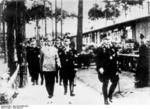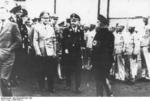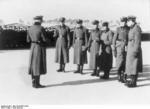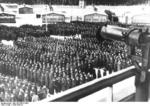Sachsenhausen Concentration Camp
| Type | 38 Prison Camp | |
| Historical Name of Location | Oranienburg, Mark Brandenburg, Germany | |
| Coordinates | 52.765833000, 13.264167000 |
Contributor: C. Peter Chen
ww2dbaseSachsenhausen Concentration Camp was located in Oranienburg, Germany, 35 kilometers (22 miles) north of the capital of Berlin. It was established in 1936, replacing the nearby smaller Oranienburg Concentration Camp. A small extension to added to the northeastern corner of the camp in 1938 in order to expand prisoner capacity. A stone wall 3 meters (9.8 feet) high ran along the entire perimeter of the camp. Within the stone wall, electric fences, armed guards, and dogs prevented prisoners from even getting close to the wall. In fact, any prisoner who roamed too close to the electric fence from the inside would be shot without warning. In 1941, a new small camp was added outside the northern perimeter wall to hold special prisoners that required isolation. The camps' prisoners were primarily political prisoners. These prisoners served as forced laborers for the Nazi government, performing work in, for example, foreign currency counterfeiting, military aircraft manufacturing, and brick production. Some of the prisoners were also employed to test new designs of military footwear; these prisoners were forced to march for 25 to 40 kilometers (about 16 to 25 miles) per day, sometimes with heavy loads on the back, to test the endurance of the test subjects. The camp also served as a training center for Schutzstaffel (SS) officers who were assigned to a career in concentration camp administration. Jews who were imprisoned at Sachsenhausen in its early years were relocated to Auschwitz in occupied Poland in 1942 for extermination. Toward the end of the war, about 13,000 Soviet prisoners of war arrived at Sachsenhausen. In Mar 1943, a gas chamber was built at Sachsenhausen, thus the camp gained a local means of extermination. Between 20 and 21 Apr 1945, 33,000 prisoners were forcibly marched to the northeast, ahead of oncoming Soviet troops; thousands of them would die en route. On 22 Apr, Soviet troops arrived at the camp, liberating the 3,000 prisoners who were left behind.
ww2dbaseBetween 1936 and Apr 1945, about 200,000 people entered Sachsenhausen Concentration Camp. About 30,000 of died from malnutrition, starvation, disease, and various forms of violence (10,000 of whom were Soviet POWs).
ww2dbaseAfter the war, the camp was taken over by the NKVD organization of the Soviet Union. In Aug 1945, Special Camp No. 7 was relocated to the site of the former Sachsenhausen Concentration Camp for holding accused and convicted Nazi war criminals. Some time later, it was renamed Special Camp No. 1. Between 1945 and 1950, 60,000 people entered Soviet Special Camp No. 7/No. 1; 12,500 of them would die from malnutrition and disease.
ww2dbaseAfter the Soviets, the East German police and then army took control of the camp site. In 1956, memorials began to be established on the site. Today the memorials, and two later-added museum (one dedicated to the German period, the other to the Soviet period), stand on the grounds of the former concentration camp.
ww2dbaseSource: Wikipedia
Last Major Update: Nov 2017
Sachsenhausen Concentration Camp Interactive Map
Photographs
 |  |  |  |
Sachsenhausen Concentration Camp Timeline
| 5 Jun 1936 | Esterwegen Concentration Camp in Germany was closed to be converted to be a punishment camp; prisoners of Esterwegen were ordered to build the Sachsenhausen Concentration Camp. |
| 23 Oct 1942 | Auschwitz-bound prisoners in the Sachsenhausen concentration camp in Germany staged a revolt that resulted in failure. |
| 1 Dec 1943 | Rudolf Höss was assigned to the SS-Wirtschafts-Verwaltungshauptamt based at the Sachsenhausen Concentration Camp in Oranienburg, Germany. |
| 20 Apr 1945 | Thousands of prisoners were marched out of Sachsenhausen Concentration Camp in Germany toward the northeast, ahead of oncoming Soviet troops. Many of them would die en route. |
| 21 Apr 1945 | Thousands of prisoners were marched out of Sachsenhausen Concentration Camp in Germany toward the northeast, ahead of oncoming Soviet troops. Many of them would die en route. |
| 22 Apr 1945 | Polish 2nd Infantry Division captured Sachsenhausen Concentration Camp, Oranienburg, Germany, with a prisoner population of about 3,000 at the time. |
Please consider supporting us on Patreon. Even $1 per month will go a long way! Thank you. Please help us spread the word: Stay updated with WW2DB: |
Visitor Submitted Comments
21 Jun 2023 04:49:34 AM
My grand father ,Pinkwasser Avraham,was taken in 1936 from his home in Berlin to Sachsenhausen camp.
We never heard from him.
Can I get any informations,pictures and other documents about him???
Thak you,
Yuval Abramsohn (son of his daughter, Reni Pikeasser-Abramsohn)
All visitor submitted comments are opinions of those making the submissions and do not reflect views of WW2DB.
| WW2-Era Place Name | Oranienburg, Mark Brandenburg, Germany |
| Lat/Long | 52.7658, 13.2642 |
 |
- » 1,167 biographies
- » 337 events
- » 44,610 timeline entries
- » 1,243 ships
- » 350 aircraft models
- » 207 vehicle models
- » 376 weapon models
- » 123 historical documents
- » 261 facilities
- » 470 book reviews
- » 28,510 photos
- » 365 maps
Fleet Admiral Chester W. Nimitz, 16 Mar 1945
Please consider supporting us on Patreon. Even $1 a month will go a long way. Thank you!
Or, please support us by purchasing some WW2DB merchandise at TeeSpring, Thank you!
20 Nov 2017 11:55:36 PM
Indeed great article. Its one of the first camp that was set up. The structure of camp was initially like a triangle so that a guard at one of the corner would have a bird's eye view over the camp. The flaw of this construction was that it couldn't be expanded and hence the extra huts/barracks outside the camp.
As mentioned, the prisoners were mainly political opponents but there were also good number of Jews, Homosexuals and Mentally Challenged and persons with disabilities.
One of the popular prisoner was son of Joseph Stalin, Yakov. He was captured in the Batlle of Smolensk by Nazis. When it was found out that he is Stalin's son, Germans tried to negotiate him with a Nazi Field Marshall at which Stalin refused saying that he would not trade the field marshal, as he was higher ranking than Yakov, and also that his son was no different than the “millions of sons” the Germans had captured. He was shot dead in the camp.
The officer's mess was green in color and often some prisoners were sent there to work either as waiters or means of entertainment. It was known as green monster among the prisoners.
Post liberation the camp was taken over by Soviet Army and was again used as Prisoner Camp.
The nearby Officer Training facilities are still in use as Brandenburg Polizei Training Camp.